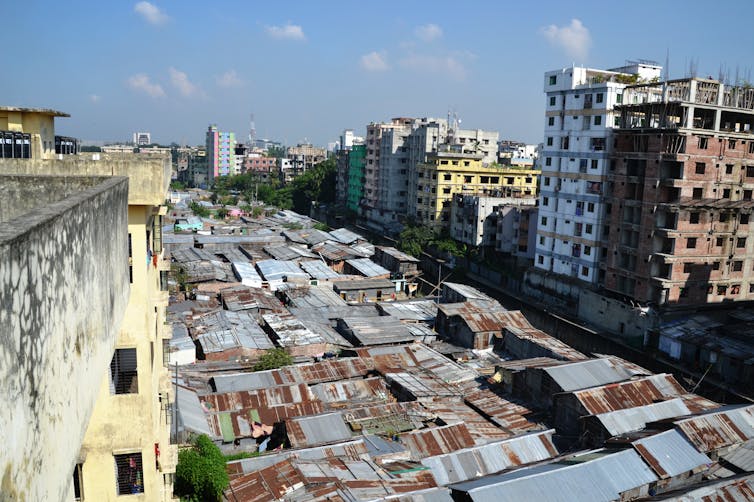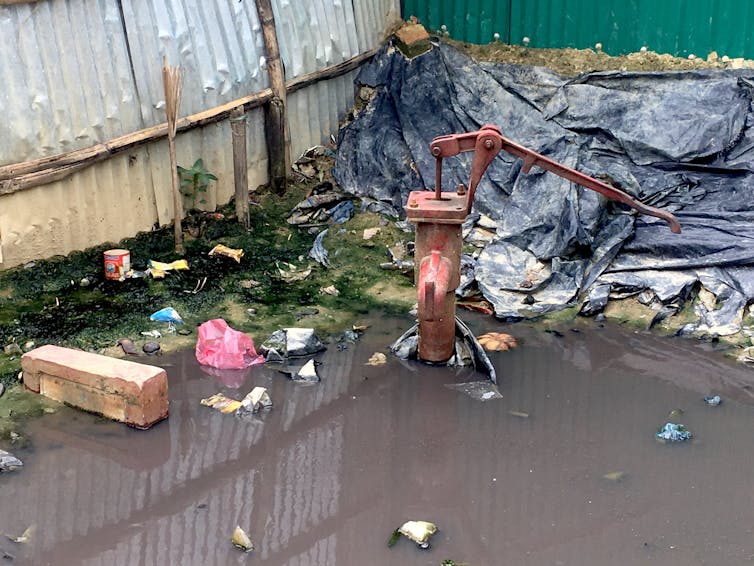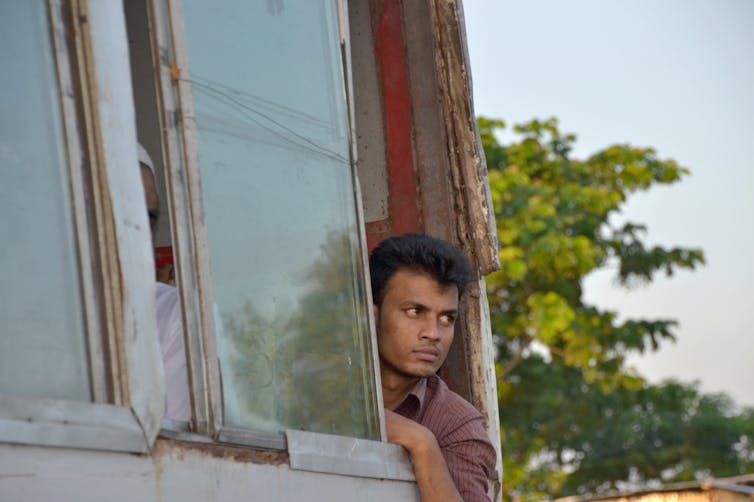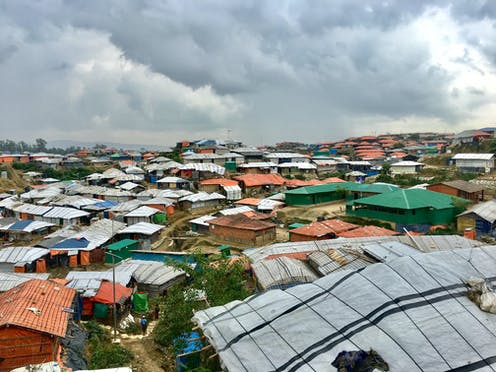© Istiakh Ahmed, Author provided
Out of the 79.5 million people who were forcibly displaced in 2019, an estimated 26 million were refugees. Approximately a third of the world’s refugees live in camps. Most displaced people, a total of 50.8 million in 2019, were internally displaced within their own countries. Recent media reports indicate that COVID-19 is spreading in refugee camps such as Idlib in north-west Syria, as well as within temporary settlements hosting refugees in Bangladesh, Greece, Lebanon and Palestine.
When the pandemic struck, COVID-19 handwashing guidelines did not pose a problem for many people. For those already battling poor access to water, however, the situation is somewhat different. In many slums and refugee camps people need to fetch water, sometimes far from their homes.
Washing their hands more often does not simply mean opening a bathroom tap. Some already struggled to gather enough water to drink, cook, and use for sanitary purposes each day. Social distancing is also nearly impossible to achieve in the narrow lanes and pathways of some settlements.

© Sonja Ayeb-Karlsson
For these extremely vulnerable populations, the pandemic has added pressure to already strained living conditions and healing processes. The closure of a school, for example, is devastating to a child who has just found a safe haven and begun to rebuild hope. A safe and consistent social environment is key to successfully processing traumatic events. Similarly, for a parent who barely manages to put food on the table, a lost job can be the difference between life and death.
For some time, refugee camps appeared to have been relatively spared from the impacts of the pandemic, but a UNHCR report released in September indicated that approximately 20,000 people of concern across 97 countries had tested positive. This number is believed to only be the tip of the iceberg.
The Rohingya camps
Bangladesh currently hosts over a million displaced Rohingya refugees. Approximately 860,000 of them are seeking shelter in the largest refugee camp in the world located in Cox’s Bazaar.
The Rohingya refugee camp has been estimated to have an average population density of 40,000 people per km². That is 40 times higher than the rest of the country and higher than many other refugee camps in the world. This makes it extremely difficult to maintain social distancing. The average family size is around four to six people and many of them live in poorly ventilated single rooms.
Roughly 13,500 handwashing stations were set up in April across the camp to reduce the spread of COVID-19. Efforts were also made to reduce movements within as well as in and out of the camp. An island close by was being used as a quarantine area for people who tested positive. Investments have been made to strengthen and increase the responses of local hospitals and health services.

© Istiakh Ahmed
The area was declared a red zone in June. Warnings and cautions that the measures were inadequate have been frequent since the beginning of the pandemic.
A phone-based, WHO-guided symptom survey was conducted among 909 households in the refugee camps and published in May. The results suggested that, at the time, 24.6% of the interviewed camp residents reported at least one common COVID-19 symptom. The study also found that religious and social gatherings may be threatening the efforts to slow down the spread of the virus. It was indicated that fear and stigma was already resulting in people delaying or avoiding to seek care, and even that some infected people were being denied treatment.
Self-isolating in a refugee camp
It is still too early to get a good picture of how the pandemic has impacted people on the move, whether displaced in their own countries or seeking refuge elsewhere. That said, in an article I recently published with a colleague we give an overview of what we do know.
We know that people in refugee camps and slums or informal settlements often live in overcrowded spaces while struggling with fragile health care systems and lacking basic infrastructure for water and sanitation. Migrants and refugees are sometimes not entitled to support services available to other citizens, and conflict-traumatised refugee populations often do not trust or seek help from the official authorities when feeling unwell.
We have also seen how fear about the pandemic sometimes results in more hostile environments for migrant populations. People on the move are, for example, increasingly being sent back to origin or transit countries, or ended up “trapped” in vulnerable situations as restrictions upon national and international movements are imposed.
About a billion people around the world, including approximately 30–50% of the urban population in the global south live in slums. This is also where many internally displaced people and internal environmental or seasonal labour migrants settle down. Imposing lockdowns in these areas can leave millions of people stranded without food.

© Sonja Ayeb-Karlsson
A global pandemic requires global solutions. Financial and social support must be provided to safeguard people who cannot work. Free handwashing stations need to be set up and entrusted figures should raise awareness of how to prevent the spread. Any evacuation or quarantine measure must also avoid family ruptures. People should be allowed to move and self-isolate with their loved ones if they cannot self-isolate at home.
It is important that we remember this brutal lesson. Many of us knew that the living conditions of vulnerable people on the move were unacceptable before. All COVID-19 has done is shine light on the risk that comes with such neglect.
We must refuse to see vulnerable people being pushed aside, and speak up against human rights violations. People must never end up in situations where they cannot ensure their health and safety due to social and economic inequalities. If there is one thing the pandemic has taught us, it is that a more sustainable future will benefit us all.
![]()
Dr Sonja Ayeb-Karlsson works for UNU-EHS. She is also affiliated with University of Sussex, part of WG1 of the Lancet Countdown, and an editorial board member for Climate and Development, UCL Open: Environment and SEI WeAdapt.











